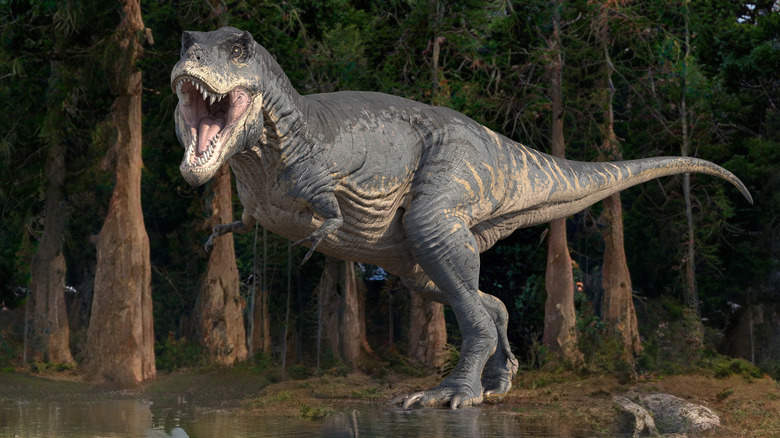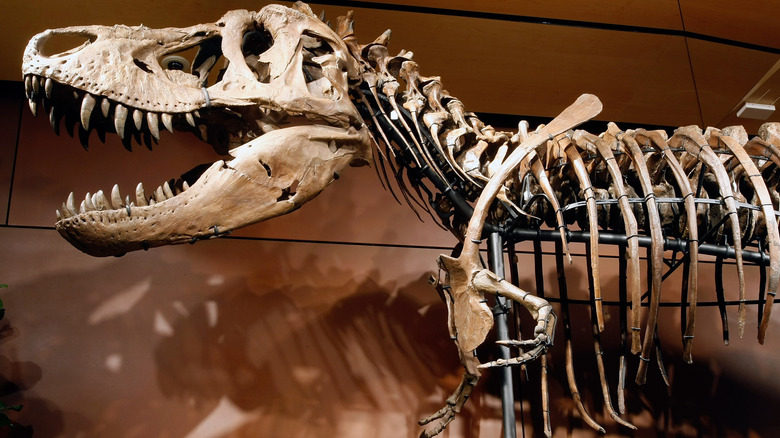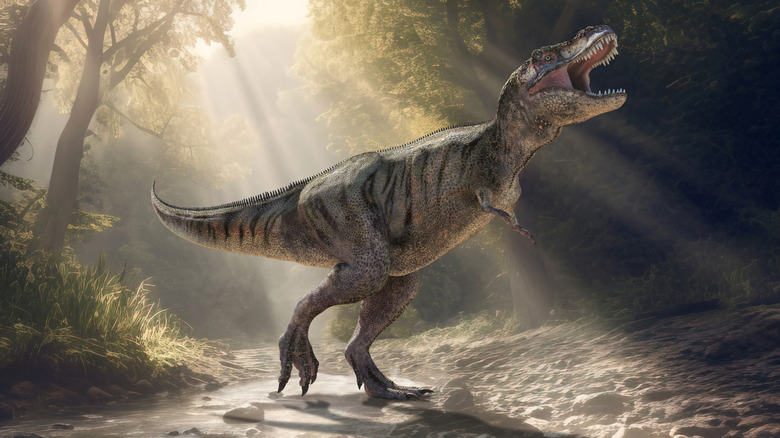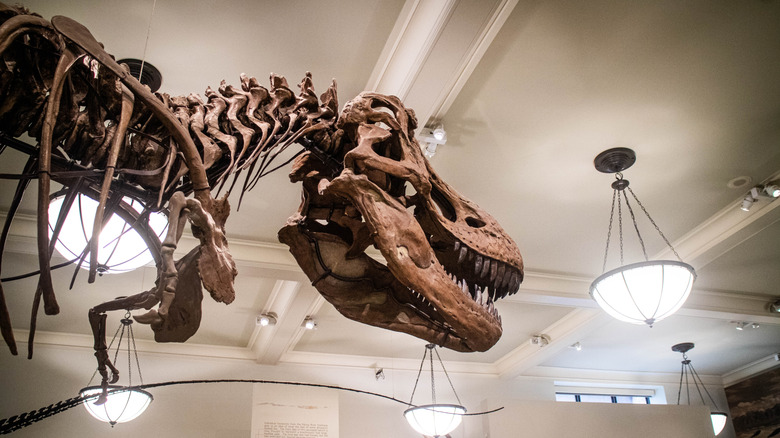What If T. Rex Had Long Arms?
Of all the dinosaurs that once roamed the Earth, none has left a more formidable legacy than Tyrannosaurus rex. Its name means "king of the tyrant lizards," and boy did it ever live up to that title. The largest carnivore in its ecosystem, T. rex could reach over 40 feet long and 15,000 pounds in weight. These fearsome predators chomped down on their victims with the most powerful bite force of any land animal ever known (the only bite that could outmatch it belonged to the whale-eating megalodon). T. rex was the closest thing to Godzilla that has ever walked the planet, and yet one of their features seems woefully out of step with this formidable aura. What's the deal with those dinky little arms?
Tyrannosaurus rex's arms were only about three feet long, bizarrely small for a creature whose every other feature was larger than life. Scientists have been baffled by the tiny appendages, and there isn't a firm consensus as to why they weren't longer. Some have suggested that T. rex used its arms in combat or hunting, or even to grip onto a partner when mating, but the limbs' feeble nature makes any of these uses seem like a stretch. Some have even proposed that T. rex's arms were a vestigial feature with no purpose.
As strange as it may sound, having longer arms might actually have been a disadvantage to T. rex. If their limbs had been proportional to the rest of their bodies, they would have caused some serious problems.
Longer arms could make balance an issue
One of the leading theories behind why Tyrannosaurus rex had short arms pins the blame on their extremely large heads, suggesting that both features evolved in tandem. T. rex was one of the final dinosaurs in existence, living just before the last of Earth's major extinction events. It was the last in a long line, and analyzing the fossils of earlier tyrannosaurid species reveals that the short arms and huge head were not always present. Over time, tyrannosaurids' skulls got bigger, evolving into giant bone-crushing machines that overpowered any prey, but the bigger the skull got, the heavier the dinosaur's forequarters became. Something had to be done to offset the added weight, and evolving smaller arms would do the trick nicely.
If T. rex had longer arms, they would create a significant issue regarding balance. The beast would be extremely top-heavy, so in order to avoid falling flat on its face at every turn, something else would need to be done to offset the weight. Developing a larger tail could have provided balance, but would also slow the dino down. While nobody can say for certain how fast T. rex was, some scientists have argued that it would have only been about as fast as a human, limited by its already tremendous weight. Adding any more pounds could make it harder to chase down prey, so having to balance out a set of longer arms might seriously limit T. rex's predatory power.
T. rex would hunt differently with longer arms
Having longer arms would have completely changed Tyrannosaurus rex's hunting habits. Unsurprisingly, there is no evidence to suggest that those tiny arms were involved in hunting in any capacity. Instead, T. rex used its massive and powerful jaws to bring down its prey. Who needs claws when you have a mouthful of serrated teeth the size of bananas that can rip huge chunks of flesh from your victim with every bite? Plus, they probably didn't need to use many fine motor skills considering the fact that they often attacked massive targets such as sauropods (varieties of long-necked dinosaurs). However, if T. rex had longer arms, it might have approached its prey in a completely different way.
If T. rex had longer arms, its hunting style probably would have been more like that of Allosaurus, a similar-looking theropod (bipedal, usually carnivorous dinosaurs) that lived roughly 55 million years before T. rex. Its arms were longer than those of T. rex, and it is widely believed that they were used to hold prey in place while Allosaurus chowed down, similar to the way that falcons eat. Allosaurus probably ate smaller prey than T. rex, using its claws to aid its jaws. There was another theropod called Baryonyx, whose arms were so long that it could walk on four limbs at times, and it was able to reach into waterways to catch fish. If T. rex had arms that long, it might have terrorized the rivers as much as the land.
Long arms could result in gruesome injuries
If Tyrannosaurus rex had long arms, it might be as much of a threat to itself as to others. One of the leading theories behind why this dinosaur has such short arms suggests that it was an adaptation to avoid accidental injuries during hunts. Tyrannosaurids likely engaged in pack hunting, descending upon large herbivores and devouring them as a group. This same type of behavior has been observed in two of the largest and most fearsome reptiles that live today — crocodiles and Komodo dragons — but it can have gruesome consequences. When a pack of Komodo dragons or crocodiles crowd around a carcass, they sometimes injure each other with their gnashing jaws, either by accident or in competition for food.
If T. rex had long arms, those limbs could easily get in the way of other T. rex jaws while engaged in a feeding frenzy. If one of these dinosaurs was unfortunate enough to have its arm bitten, the bone-crushing force would have completely destroyed the limb, which could lead to death by blood loss or infection.
As counterintuitive as it may seem, having puny little arms was actually a huge advantage for T. rex, and having longer ones would have exposed it to severe injuries and thrown its balance way off. In fact, long arms were so disadvantageous, that some scientists believe if T. rex was still alive today, it would have by now evolved to have no arms at all.



